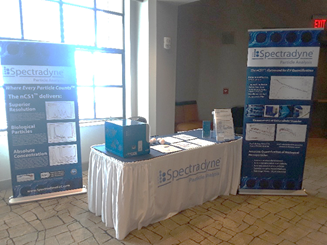

Spectradyne recently exhibited at the Circulating Biomarkers World Congress in San Diego, a conference focused on using measurements of extracellular vesicles (EVs) for diagnosis of various health issues. This was a small but great, focused, show that confirmed how hot the EV area is! Back to table of contents
Research into EVs (or exosomes, or nanovesicles) as biomarkers is rapidly expanding, and has become an important area of the more general discipline of liquid biopsy. Health areas being investigated with exosomes biomarkers include cancer, cardiovascular disease, reproductive issues, and neurodegenerative disease, among others.
Of course, any exosome-based diagnostic technique must be able to differentiate healthy from unhealthy patients by quantifying the presence of the exosome biomarker or biomarkers in question. This could be as "simple" as quantifying the concentration of one population of exosomes, or more complex, for example in comparing the concentrations of multiple types of nanovesicles (or perhaps vesicles compared to non-vesicles), to establish a "fingerprint" of a disease.
In our conversations at the conference, it was clear that that while most researchers have an approach to determine whether a target EV (or related DNA or microRNA) is present in a liquid biopsy, there is much less expertise in accurate quantification of biomarker concentration.
Spectradyne's technology is well suited to this kind of exosome measurement challenge (see some examples
here). Our microfluidic resistive pulse sensing (MRPS) technology counts vesicles (or other particles) individually and therefore builds up highly accurate statistics on nanoparticle concentration across any size range from 50 nm to 10 microns. For our technology, high levels of polydispersity are handled easily. This allows the researcher to clearly establish the level of background nanoparticles relative to the exosome population in any biological fluid (we measure serum, plasma, urine, and cell culture media routinely), which is important because the relative measure of exosome "signal" compared to background can be critical to the quality of the diagnostic conclusion.
Finally, importantly, MRPS is a non-optical technology and therefore provides a key check on the findings of other metrology methods, most of which are based on light scattering. Biases related to the optical properties of the exosomes or nanovesicles are inconsequential to our MRPS method, and this can lead to important insights that are otherwise missed if only optical analyses are done (see this article for an example).
The Circulating Biomarkers conference was exciting in terms of the high quality of science on display as well as the energy of the researchers. We look forward to seeing more of this at our next big conference, ISEV, in Kyoto in just a couple weeks!
Please continue to follow our blog as we share insights, technical details, and generally geek-out with you about nanoparticle science!
Email us for more information, or to discuss your particular application directly.

Spectradyne's booth at Circulating Biomarkers 2019